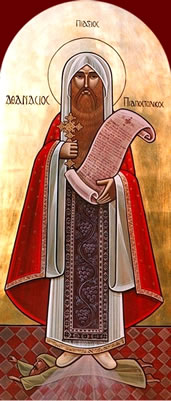Early Egyptian Monasticism
In the early Christian church, the early Egyptian monks were the most renowned and had the greatest influence. Both major forms of monasticism, anchoritic and cenobitic, have deep roots in Egypt, beginning in the third century. Anchoritic monks pursued asceticism and spiritual growth by withdrawing from society and living in solitude as hermits, whereas cenobitic monks pursued the same ideals by living together with other monks in a communal home.
The most famous of the anchoritic or hermit monks was St. Anthony (251- c. 355). Tradition considers him to be the founder of anchoritic monasticism, but he is more properly considered its most prominent model. Anthony’s fame and influence grew even more after his death as a result of Athanasius’s Life of Anthony which portrayed Anthony as having achieved exceptional spirituality and details his many battles with demons. The fame of another notable Egyptian anchoritic monk, Paul of Thebes, was assured when Jerome composed a Life of Paul. According to Jerome, Paul withdrew to a desert cave to flee from the persecutions of Decius and Valerian (250-260) when he was fifteen years old and remained there until his death at the old age of 113, all the while living on bread brought by a crow each day. The stories about these two men encouraged and inspired many monks for centuries to come.
Pachomius (292-347) is considered the father of cenobitic or communal monasticism. Although he was not the first to form a monastic community, the Rule of Pachomius became the most well-known and influential organizational code throughout Egyptian monasticism. The other great influence on Egyptian cenobitic monasticism was Shenoute (c. 350-466), the head of the White Monastery and one of the most prolific Coptic writers. He built upon the monastic rules of Pachomius, making them stricter and requiring all of the monks to take oaths. The work of these two monks was influential in shaping the structures and practices of monasteries far and wide for centuries to come.
For a hypothetical reconstruction of a Pachomian monastery (based on the Pachomian Rule), click here. For references in Pachomius’ rule, click here.
For a list of the various AREAS or of the various DUTIES/POSITIONS within a Pachomian monastery, click here.
*Dates taken from Encyclopedia of Ancient Christianity, Di Berardino.
Bibliography:
Dunn, Marilyn. The Emergence of Monasticism: From the Desert Fathers To the Early Middle Ages. Oxford, UK: Blackwell Publishers, 2000.
Goehring, James E. “Monasticism.” In Encyclopedia of Early Christianity. Edited by Everett Ferguson. New York: Garland Publishing, Inc. 1990, pp. 612-619.
Gribomont, Jean. “Pachomius.” In Encyclopedia of Ancient Christianity. Edited by Angelo Di Berardino. Downers Grove, IL: InterVarsity Press, 2014, Vol. 3, pp. 1-2.
Harmless, William. Desert Christians: An Introduction to the Literature of Early Monasticism. Oxford University Press, USA, 2004.
Orlandi, Tito. “Anthony, abbot.” In Encyclopedia of Ancient Christianity. Edited by Angelo Di Berardino. Downers Grove, IL: InterVarsity Press, 2014, Vol. 1, p. 142.
Orlandi, Tito. “Shenoute.” In In Encyclopedia of Ancient Christianity. Edited by Angelo Di Berardino. Downers Grove, IL: InterVarsity Press, 2014, Vol. 3, pp. 576-577.
Wipszycka, Ewa. “Paul of Thebes.” In Encyclopedia of Ancient Christianity. Edited by Angelo Di Berardino. Downers Grove, IL: InterVarsity Press, 2014, Vol. 3, p. 114.
Introduction by RMS
Updated 12/5/15 by NJ
No Responses yet
